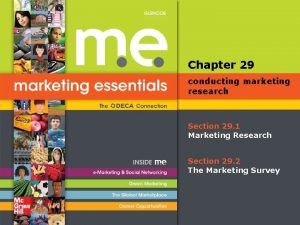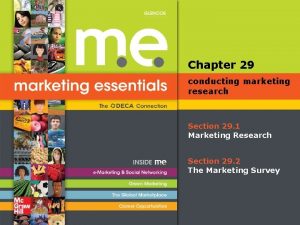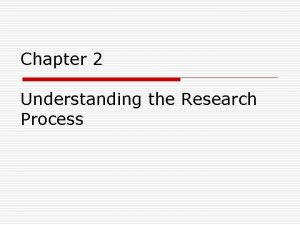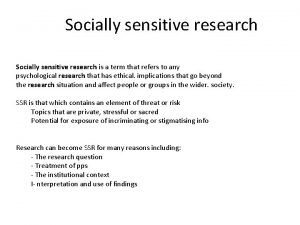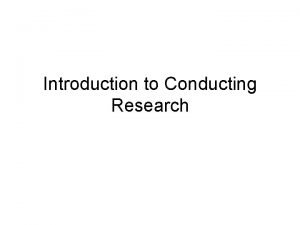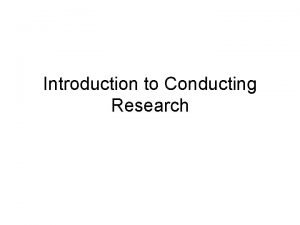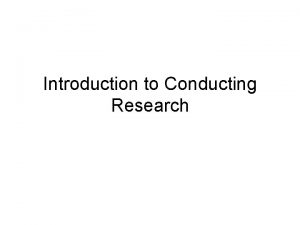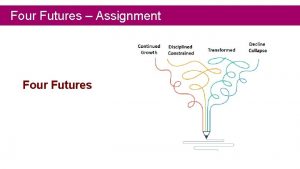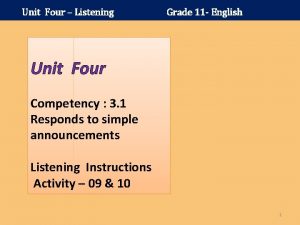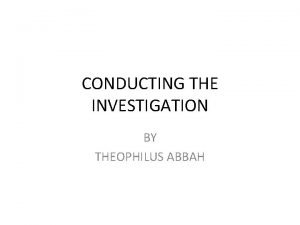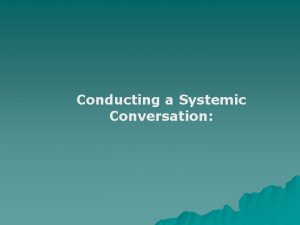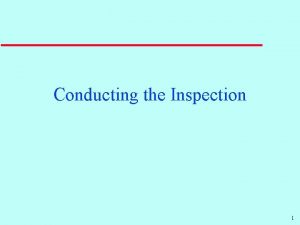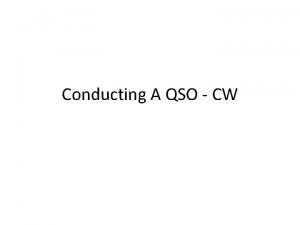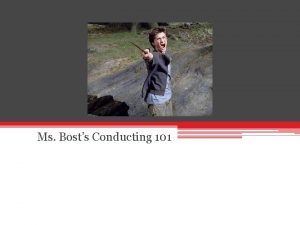Unit Four Process in Conducting Research The Research



























- Slides: 27

Unit Four Process in Conducting Research

The Research Process • Stages in the research process: ü Conceptualization – idea on the research process –(unit 3: Problem identification) ü Contextualization – putting your research in the context of others –(unit 3: proposal dev’t) ü Data collection and analysis – (this unit) ü Reporting – writing up of your research (unit 6)

Data collection and Analysis • Choose the most suitable research method for your study according to the approaches used. ü Quantitative research – involving numerical and statistical data. Emphasis on quantitative observations. ü Qualitative research – gathering non-numerical data. Emphasis on qualitative results.

Research methods – Common Types • Observation studies • Questionnaires • Interviews • Focus groups • Document analysis • Mathematical modeling • The experimental method

Research methods – Common Types • Observation studies- the process of observing and recording events. Two types – participant (observer as participant) and nonparticipant Based on time concern of the study Retrospective (Past events) and Prospective (Present and future events)

Research methods – Common Types • Questionnaires – a tool where respondents answers to questions. • It could be open or closed/fixed. • Flexible and can be applied on almost any topic Data collection: Questionnaire forms (hard copies), web based questionnaires. E. g. Why do you apply for graduate program? 1 – to expand my knowledge 2 - to earn a better salary after graduation 3 – to get promotion 4 – no specific reason Open Closed

Research methods – Common Types • Interviews – tools where questions are delivered in a faceto-face encounter. ü It is limited to cases where the subjects of study can respond subjectively but with sufficient knowledge ü It can be approached in pure quantitative (structured) and pure qualitative (not structured) perspective ü Mainly interviews are semi-structured Data collection: Structured– ticking/writing on a form Less structured data – taping and taking notes

Research methods – Common Types • Focus groups – a type of interview but targeting only carefully selected individuals usually who do not know each other. ü It is useful in providing qualitative data ü Facilitates obtaining thematic understandings E. g. Study on identification of design requirements of a manual coffee grinder

Research methods – Common Types • Document analysis/content analysis – the process of using documents, records, films, photographs, books, etc. relating to our research interest. ü It is an indirect form of research (original data is not generated) ü It is a non-reactive method. ü Reliability and validity are the central concerns Typical example: review of studies conducted on material for smartphone cover

Research methods – Common Types • Mathematical modeling – used to analyze relationships between different variables and to predict possible outcomes, or causal effects. • Regression analysis, structural equation modeling, previous mathematical models etc… E. g. Mathematical model of Torque in a DC Motor τ= F R sinθ Where, F - force in linear direction. R - radius of the object being rotated, and θ - the angle, the force F is making with R vector

Research methods – Common Types • Experimental method – involves setting up an experiment in order to test a particular theory or hypothesis. ü Laboratory/computerized experiments – small scale study and subjects are studied in a controlled environment. E. g. bio-technology, chemistry, medical studies ü Field experiments – research conducted outside the laboratory and researcher control is reduced. E. g. agricultural studies

Analyzing and Interpreting Quantitative Data Steps in quantitative analysis and interpretation: ü How do you prepare the data for analysis? ü How do you analyze the data? ü How do you report the results? ü How do you discuss the results?

Analyzing and Interpreting Quantitative Data Preparing the data for analysis? ü Score data by assigning numeric codes to responses ü Create codebook ü Create data file in data grid ü Create variable, value labels ü Clean database, missing values

Analyzing and Interpreting Quantitative Data Select a statistical program for quantitative studies: ü Statistical Package for Social Sciences- SPSS is most popular ü Other programs: Mini-tab, Statview, SAS, Stat. Pac ü Advanced analysis with Mat. Lab and other specialized software

Analyzing and Interpreting Quantitative Data How do you analyze the data? Conduct descriptive analysis: üMeasures of central tendency üMeasures of relative standing Descriptive Statistics Central Tendency Mean Median Mode Variability Variance Standard Deviation Range Relative standing Z-Score Percentile Ranks

Analyzing and Interpreting Quantitative Data Ø Conduct inferential analysis: ü Hypothesis testing ü Confidence interval Ø Identify a null and alternative hypothesis Ø Set the level of significance (alpha level) for rejecting the null hypothesis Ø Compute the sample statistic Ø Make a decision about rejecting/failing to reject

Analyzing and Interpreting Qualitative Data Codes the Text for Description to be Codes the Text for Themes to be Used in the Research Report The Researcher Codes the Data (i. e. , locates text segments and assigns a code to label them) The Researcher Reads Through Data ( i. e. , obtains general sense of material) The Researcher Prepares Data for analysis ( e. g. , transcribes field notes) The Researcher Collects Data (i. e. , a text file, such as fieldnotes, transcriptions, optically scanned material)

Interpreting Qualitative Data ü Interpretation is not neutral ü Reflect about the personal meaning of the data ü Compare and contrast personal viewpoints with the literature ü Address limitations of the study ü Make suggestions for future research

Sampling Terms and Procedures • Population - inclusive group defined by researcher • Sample - representative subset of population Should contain essential elements of population • Random Sampling - process of sampling which assures that any subject in the population has an equal probability of being in the sample • Systematic counting - uses list to choose every nth person from the population • Stratified Random - used when researcher believes the population has distinct subgroups. E. g. : if population has 45% men, then we make sure sample is 45% men

Sampling Strategies • Clustered Sampling: Sampling Select a sample from only those parts of the population which are relevant; e. g. Choose only those people who use the road at peak hour. • Destructive Sampling: Sampling If the sample is destroyed by sampling (i. e. their mind is changed), then clearly you should not sample all people.

Individual Task/assignment next week • Select International Publications of your interest (Journal, Conference paper, etc) for the problem you identified/selected • You must select at least 10 relevant articles for review • Prepare a two pages literature review report and prepare a 10 min presentation • Submit your report and present it next week

End of Unit Three

Study Design Study design - the practical way in which the research is conducted according to a systematic attempt to generate evidence to answer the research question. • Deliberately planned 'arrangement of conditions for analysis and collection of data in a manner that aims to combine relevance to the research purpose with economy of procedure. • Determined by the research questions, and influenced by available resources (time, money, people, equipment). Research methods and methodology: describes the tools used for data collection and describes the method for data analysis respectively

Example 1. Title : Accounting policies of all industries in the U. S. Research question : Will it be practical if all industries in the U. S are required to have standardized account policies, subject to one set of rules and conditions? Objectives : To examine the effect of standardized account policies on the activities of industries in the US Proposed research design : • Visit several companies and industries to get those companies’ accounting officers views on this subject (50% of research) • Visit a few banks to get opinions from one of their management staff on this subject (30%) • Browse through accounting journals, financial newspapers and the net for articles related to the subject in question (20%) • Browse through recent FASB and SEC publications (20%)

Example 2. Title : Domestic oil launch in the UK Research question : Would households in UK be willing to accept and utilize new brand Olive oil? Objectives : To examine attitudes to the use Olive oil in households Proposed research design : • The research has both quantitative and qualitative research components. In the qualitative research, focused research will be used to explore and understand the attitudes of potential customers towards a new brand. In case of the quantitative research, carry out a telephone study using questionnaire to measure how widespread these attitudes are.

Example 2. Research Method: Qualitative: 1. Population and sampling – four groups are proposed with the following profiles…… Quantitative: we set out to carry out 200 interviews in households of different sizes…. . We have set interlocking quotas as follows …. Analysis : … Timing/ work plan: The table below shows the time frame to conduct the research … Week Activity 1 -4 Desk research 4 -6 Qualitative field work

Example 2. Budget: The cost break down of the budget required to carry out the research is shown as below. Phase Description Desk research $1000 to purchase relevant reports $. . . Net browsing $. . . Quantitative Interviews Qualitative research Four focus groups Total Budget $3, 250 $10, 000 $8, 000 $20, 250
 Chapter 29 conducting marketing research answers
Chapter 29 conducting marketing research answers What is forced choice questions
What is forced choice questions Research limitation examples
Research limitation examples Socially sensitive research definition
Socially sensitive research definition Chapter 29 conducting marketing research
Chapter 29 conducting marketing research Steps in psychological research
Steps in psychological research When conducting research online the keyword
When conducting research online the keyword Conducting marketing research and forecasting demand
Conducting marketing research and forecasting demand Conducting marketing research and forecasting demand
Conducting marketing research and forecasting demand Market research demand forecasting
Market research demand forecasting Unit 10, unit 10 review tests, unit 10 general test
Unit 10, unit 10 review tests, unit 10 general test Unit process and unit operation
Unit process and unit operation What is unit operation and unit process
What is unit operation and unit process Hát kết hợp bộ gõ cơ thể
Hát kết hợp bộ gõ cơ thể Frameset trong html5
Frameset trong html5 Bổ thể
Bổ thể Tỉ lệ cơ thể trẻ em
Tỉ lệ cơ thể trẻ em Voi kéo gỗ như thế nào
Voi kéo gỗ như thế nào Glasgow thang điểm
Glasgow thang điểm Chúa yêu trần thế
Chúa yêu trần thế Các môn thể thao bắt đầu bằng tiếng đua
Các môn thể thao bắt đầu bằng tiếng đua Thế nào là hệ số cao nhất
Thế nào là hệ số cao nhất Các châu lục và đại dương trên thế giới
Các châu lục và đại dương trên thế giới Công thức tính độ biến thiên đông lượng
Công thức tính độ biến thiên đông lượng Trời xanh đây là của chúng ta thể thơ
Trời xanh đây là của chúng ta thể thơ Cách giải mật thư tọa độ
Cách giải mật thư tọa độ Phép trừ bù
Phép trừ bù Phản ứng thế ankan
Phản ứng thế ankan
